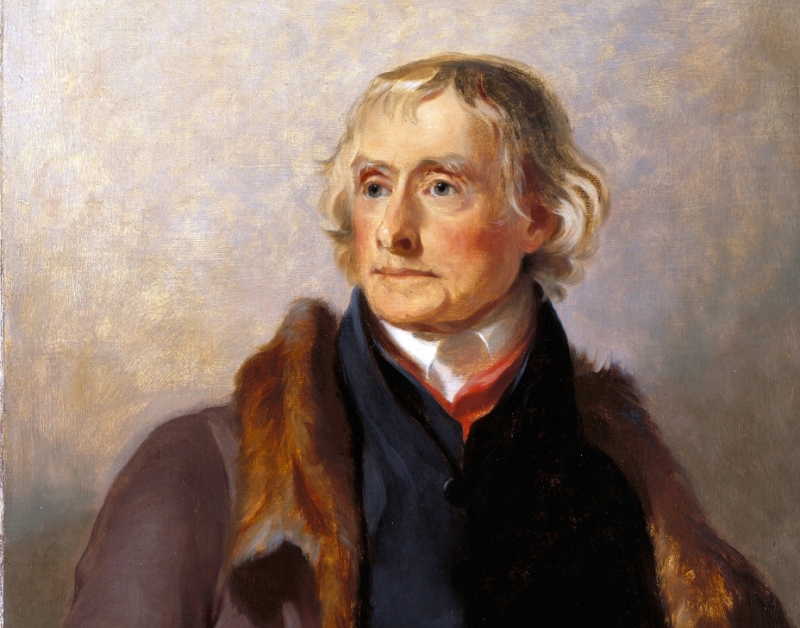
Thomas Jefferson (April 13, 1743-July 4, 1826) was a man of many parts. We all know he had a plantation, but I never knew he inherited it from his father along with a lot of debts. He graduated from the College of William and Mary, but I didn’t know he practiced law. Briefly. He represented his county in the Virginia House of Burgesses, but I didn’t know he served as the second Governor of Virginia from 1779-1781. I know he attended the Second Continental Congress and is considered the main author of the Declaration of Independence in 1776. He did not attend the Constitutional Congress in 1787 that gave us our Constitution because he was in Paris. He kept in touch with letters and during the ratification process he was instrumental in the addition of the Bill of Rights. We all know he became our third President in 1801 but I didn’t know (no blame to my history teachers I am sure) that he served as Minister to France, then Secretary of State to George Washington, and Vice-president to John Adams.
Thomas Jefferson and John Adams take a tour
There are a lot of other things I didn’t know about Jefferson including a garden tour he took in 1786. That April Jefferson was living in France as the American Minister to France, at the same time that John Adams was living in London as the American Minister to the court at St. James Palace. Adams was having difficulties with trade negotiations that stalled. He invited Jefferson to come to Britain for a week or so and tour some of the gardens. A respite. At that time British gardens were considered the ultimate in garden fashion. Jefferson agreed to come. In spite of difficulties with Britain, he did feel that the English had the most magnificent landscapes.

On April 3, the second day of their tour, they visited the famous Woodburn Farm. At that time such estates were open to the public. Woodburn was considered a “ferme ornee’ which combined the beauties of a pleasure garden with the elements of a working farm. Jefferson had been fascinated by the idea of the simple delights of a country life which included elegant landscapes. He admired the groves of trees and shrubberies that bordered paths and wound around the Woodburn’s fields and meadows. Though it was too early in the season to really see the foliage and flowers of the shrubs, the sight of the blooming crabapples, and the yellow pendant catkins of the alders was enough to feed his imagination about the kind of gardens he wanted to design and plant at Monticello.
Monticello
Jefferson was a learned man who knew about science and horticulture. Today visitors can see and enjoy the fruit (pun intended) of his passions and interests. There had been large gardens but in 1806 the 1000 foot long vegetable garden we see today was hewed and terraced out of the side of a mountain by slaves. There he grew 330 varieties of 70 vegetables. The garden mainly served the functional needs of the plantation, but Jefferson built a beautiful pavilion where he and guests could admire the magnificent view of the mountains beyond. That Pavilion was destroyed during a storm in the 1820’s. It was replaced in 1984 so that today’s visitors can imagine Jefferson sitting in solitude, or possibly showing off the view to visiting friends.
For many years Jefferson kept a Garden Kalendar. He experimented with seeds from Italy, Britain, France and Mexico. He wanted to find the best of the varieties that he planted. He loved the English pea, but he also appreciated figs and asparagus. Jefferson enjoyed planting those ‘new ‘vegetables like tomatoes, eggplant, broccoli and cauliflower.
One of the biggest, and earliest things Jefferson did while President was make the Louisiana Purchase. The size of our country was doubled when he signed this agreement with France. He sent Lewis and Clark off to explore and map the area. In addition to the maps and information about the land and the Indian tribes, he had them send back plants for his gardens.

Man cannot live by vegetable alone. Jefferson also planted an eight acre ‘fruitery.” Over time the South Orchard was planted with over 1000 fruit trees including many varieties of apples, peaches, cherries, pears, plums, nectarines, almonds, and apricots. It is said that Spitzenberg was Jefferson’s favorite apple. I am happy to say it is easy to come by in our area in season. Many of the apple trees were grown for cider. Over the years some of those trees did not thrive and died. The orchards were restored in 1981, so visitors today will see the orchard as it might have looked at its best period.
Of course, there were berries, and his grape vineyards today thrive as they could not when Jefferson made his attempts.
Jefferson continued with his many interests after his terms as President. His notable accomplishment during those years was the founding of the University of Virginia.
Nowadays Jefferson has lost some luster because he was a slave owner, as were George Washington and James Madison. Still we cannot deny the energy and wisdom that these men devoted to the creation of our country. I am as happy to celebrate his April 13 birthday as I do Washington’s.
Between the Rows April 6, 2019
He was quite the complex human wasn’t he? I must get to Monticello one of these days–it’s at the top of my garden bucket list. I’ve been near there several times, but I need to make it the destination…
Beth – I visited Monticello a very long time ago. I don’t believe a lot of this restoration work had been done. I have friends in DC. The next time we visit them we’ll have to make a trip there.